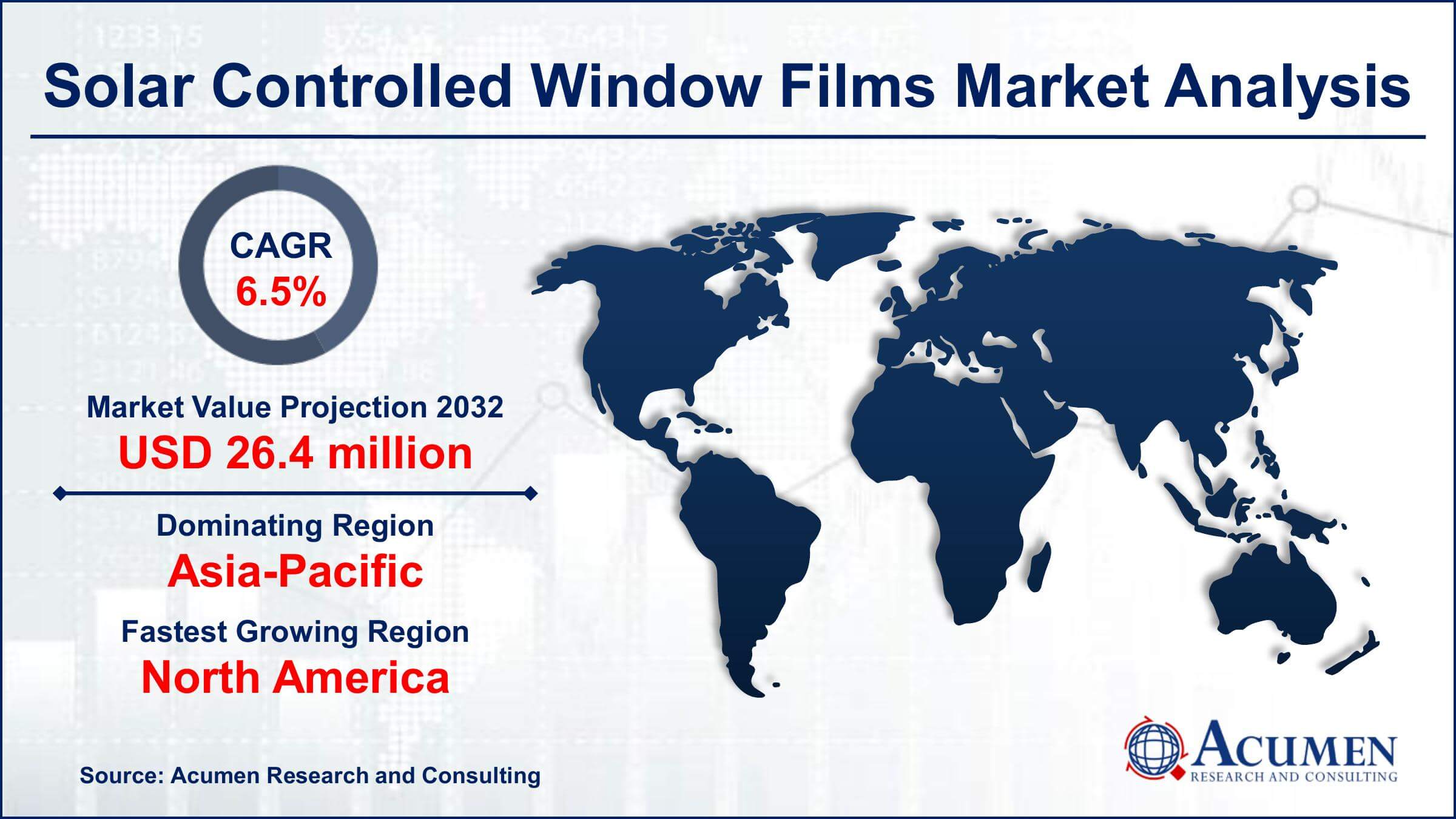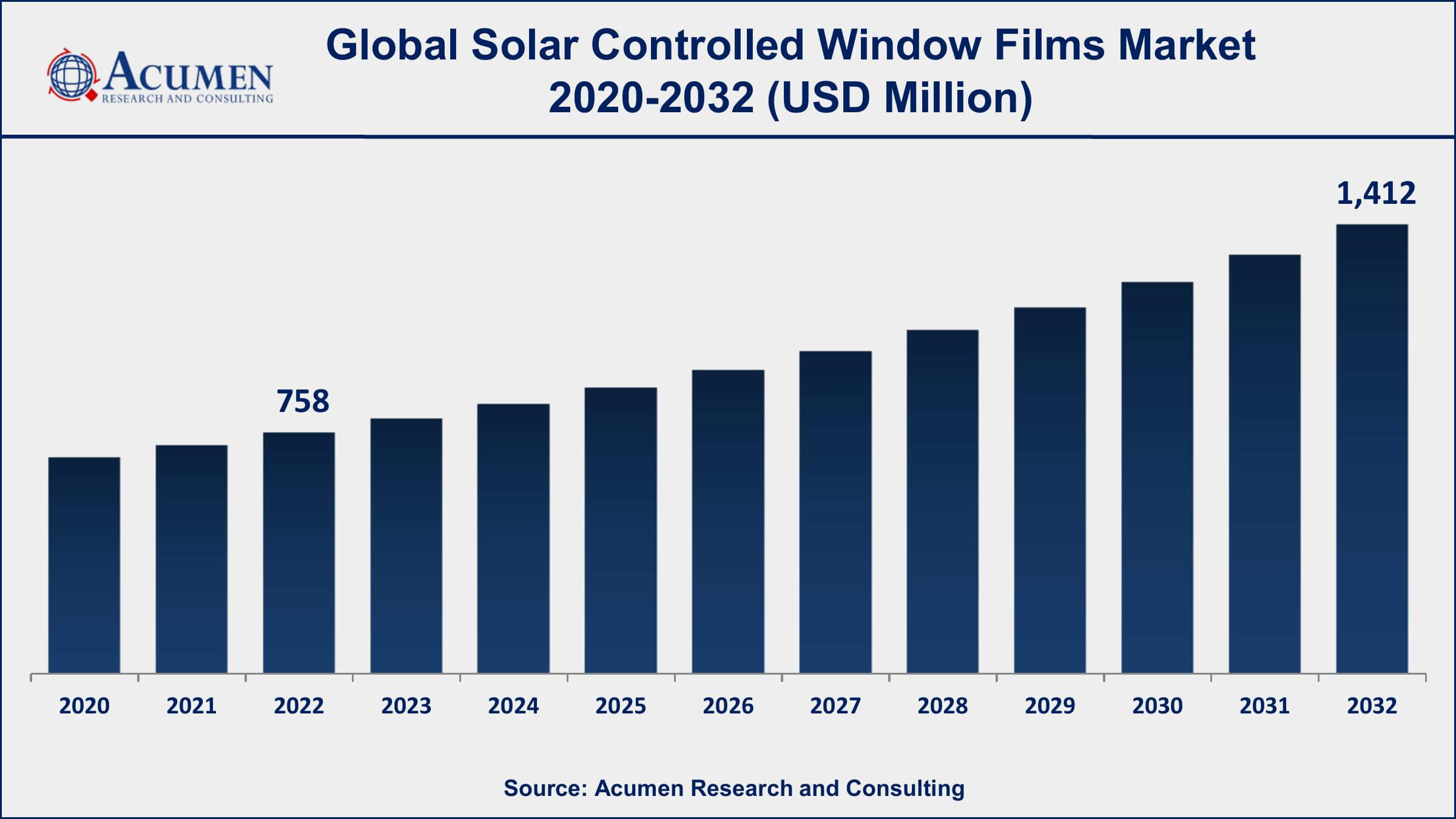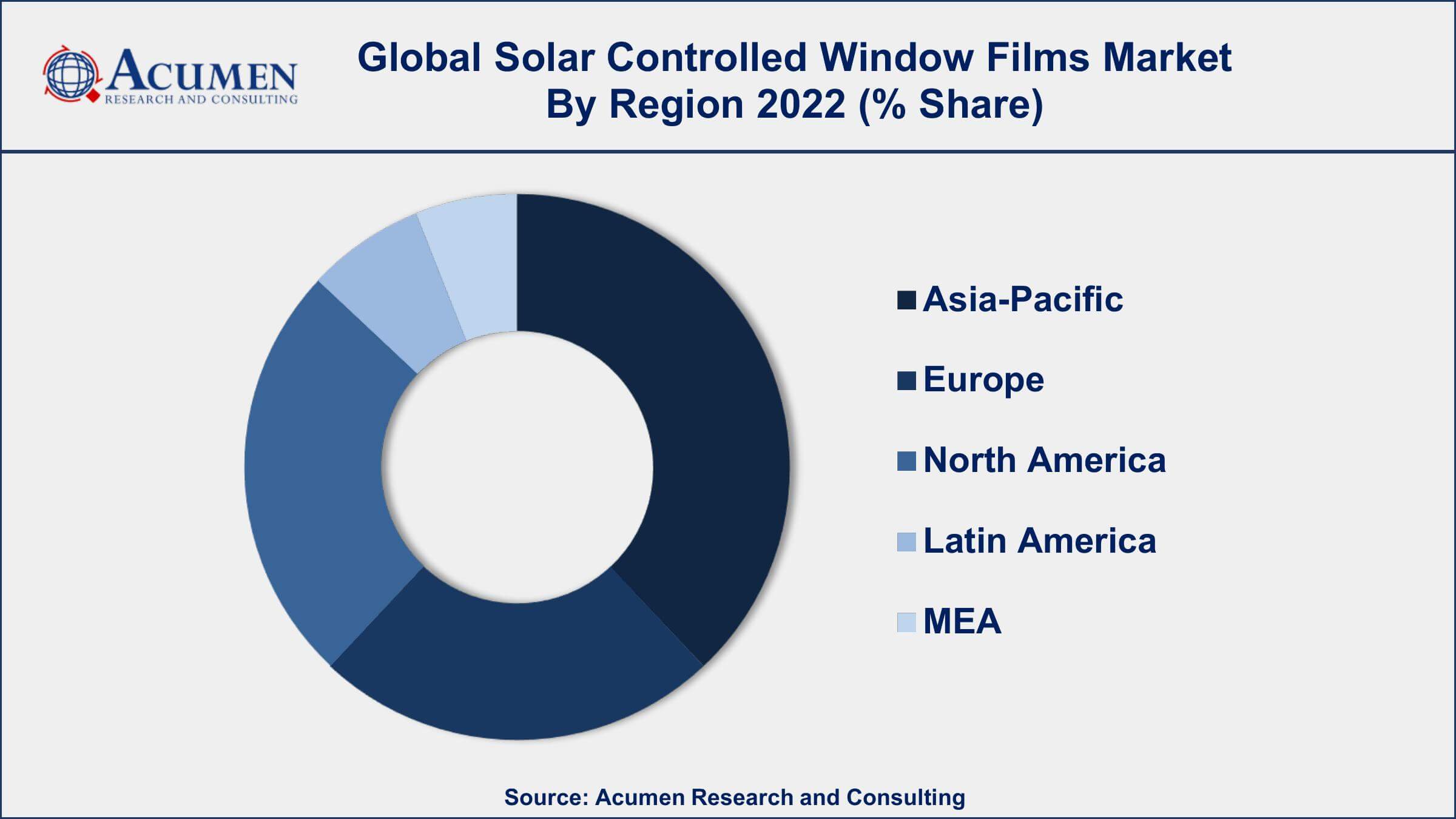Solar Controlled Window Films Market | Acumen Research and Consulting
Solar Controlled Window Films Market Size - Global Industry, Share, Analysis, Trends and Forecast 2023 - 2032
Published :
Report ID:
Pages :
Format :
The Solar Controlled Window Films Market Size accounted for USD 718 Million in 2022 and is projected to achieve a market size of USD 1,412 Million by 2032 growing at a CAGR of 6.5% from 2023 to 2032.
Solar Controlled Window Films Market Report Key Highlights
- Global solar controlled window films market revenue is expected to increase by USD 1,412 Million by 2032, with a 6.5% CAGR from 2023 to 2032
- Asia-Pacific region led with more than 35.5% of Solar Controlled Window Films market share in 2022
- According to the International Window Film Association, solar control window films can help reduce cooling costs by up to 30% and heating costs by up to 10%.
- Solar controlled window films are designed to block up to 99% of UV radiation, which can cause skin damage and fade interior furnishings.
- Among applications, the construction sub-segment generated more than 56% share in 2022
- Increasing demand for energy-efficient buildings, drives the Solar Controlled Window Films market size

Solar controlled window films are thin, transparent sheets of polyester that are applied to the interior or exterior of windows. They are designed to reflect or absorb solar radiation, reducing the amount of heat that enters a building through the windows. In addition to reducing solar heat gain, these films can also block UV radiation, which can damage furnishings and fabrics over time. Solar controlled window films come in a variety of shades and tints, allowing building owners to customize the level of light and heat that enters their space.
The market for solar controlled window films has been growing steadily over the past few years. This growth can be attributed to several factors, including increased awareness of the energy-saving benefits of these films, advancements in film technology that have improved their performance and durability, and the growing demand for sustainable building materials. Additionally, the COVID-19 pandemic has led to an increase in remote work and home improvement projects, which has boosted demand for window film installation in residential properties.

Global Solar Controlled Window Films Market Trends
Market Drivers
- Increasing demand for energy-efficient buildings
- Growing awareness about the harmful effects of UV radiation on human health
- Government regulations and incentives promoting the use of energy-efficient products
- Rising need for privacy and security in residential and commercial buildings
- Increasing adoption of renewable energy sources, including solar power
Market Restraints
- High initial cost of installation
- Limited awareness and understanding of the benefits of solar-controlled window films
- Availability of alternative energy-efficient solutions
Market Opportunities
- Growing demand from emerging economies with high growth potential
- Development of eco-friendly and sustainable window films
Solar Controlled Window Films Market Report Coverage
| Market | Solar Controlled Window Films Market |
| Solar Controlled Window Films Market Size 2022 | USD 718 Million |
| Solar Controlled Window Films Market Forecast 2032 | USD 1,412 Million |
| Solar Controlled Window Films Market CAGR During 2023 - 2032 | 6.5% |
| Solar Controlled Window Films Market Analysis Period | 2020 - 2032 |
| Solar Controlled Window Films Market Base Year | 2022 |
| Solar Controlled Window Films Market Forecast Data | 2023 - 2032 |
| Segments Covered | By Product, By Application, By Technology, And By Geography |
| Regional Scope | North America, Europe, Asia Pacific, Latin America, and Middle East & Africa |
| Key Companies Profiled | Eastman Chemical Company, 3M, Garware Hi-Tech Films Limited, Compagnie de Saint Gobain, Avery Dennison Israel Ltd. (Hanita Coatings RCA Ltd), Johnson Laminating and Coating, Inc., The Window Film Company, Sican Co. Ltd., Madico, Inc., and LINTEC Corporation. |
| Report Coverage |
Market Trends, Drivers, Restraints, Competitive Analysis, Player Profiling, Covid-19 Analysis, Regulation Analysis |
Residential and commercial infrastructures are the major consumers of solar-controlled window films, contributing a major revenue share to the market. Since the 1950s, the construction industry has been using these protective sheets deployed in windows. These protective films offer an array of purposes, which include protection against harmful UV rays that can adversely affect the furnishings and fabrics or display articles, maintaining the room temperature by blocking excessive heat from the window, lower down the air conditioner needs resulting in low energy consumption along with enhancing the look of the building. These solar films are generally manufactured from PET (polyethylene terephthalate), a common thermoplastic that belongs to the polyester family. They have outstanding optical properties and strength due to which they are used so extensively. While coating the raw material PET, it is melted and stretched bi-axially in the form of polyester sheets that are then processed rendering to their applications.
Reduction in carbon foot footprints and cost-cutting in electricity bills at a low-cost short payback period are some of its characteristics attracting residential and commercial buildings to use these films in their windows. However, the identification of suitable film, depending upon the climatic conditions of that particular region is the major challenge faced by end-users. Another challenge is to limit the additional incoming rays to the residential sector and its inability to provide privacy at night as well.
Traditionally, solar-controlled window films were utilized to permit a high solar rejection rate. Surging smart technology such as smart glass facilitates its user with reduced electricity cost by reducing the use of light, curtains, air conditioners, heating of the room, or blinders, which may become a threat to the alternative. But the high initial cost of installation of the smart glass as compared to the ordinary glass, adds an advantage for the solar-controlled window films.
Regardless of its numerous benefits, the market may witness negative growth affected by installation, technical, and warranty challenges. Nonetheless, technological advancements have facilitated clear discernibility from inside during the day as well as night, which are analyzed to propel the market growth in the coming years. Furthermore, these films are manufactured with distortion-free and clear adhesive systems coupled with scratch-free coating, for ease of maintenance and cleaning. Also, these films offer advanced safety by creating a shield across the glass and keeping the pieces of broken glass in place in any case of breakage.
Solar Controlled Window Films Market Segmentation
The global solar controlled window films market segmentation is based on product, application, technology, and geography.
Solar Controlled Window Films Market By Product
- Dyed
- Vacuum Coated Films
- Clear
According to the solar controlled window films industry analysis, the vacuum coated films segment is predicted to lead the market. These films are typically made of metal or metal oxide layers, which are applied using a vacuum deposition process onto a polyester or polymer substrate. The resulting film can offer excellent solar control performance, with properties such as high visible light transmission, low solar heat gain, and low reflectivity. Vacuum-coated films are commonly used in architectural and automotive applications to improve energy efficiency and provide comfortable interior environments. They are also used in decorative applications for their aesthetic properties, such as creating colored or reflective surfaces. The demand for vacuum-coated films in the solar-controlled window films market is driven by several factors, including increasing awareness of the benefits of energy-efficient buildings and vehicles, the need for improved comfort and privacy, and the growing popularity of smart glass technology.
Solar Controlled Window Films Market By Application
- Automotive
- Construction
- Others

In terms of application, the construction segment is accounted the largest market share in 2022. Solar controlled window films are widely used in construction for both residential and commercial buildings as they offer a cost-effective solution to improve energy efficiency and reduce cooling costs. Solar controlled window films can block out up to 99% of harmful UV rays and reduce up to 85% of solar heat gain, making them an ideal choice for buildings in hot and sunny climates. They also help to reduce glare and provide privacy, making them popular for use in offices, retail spaces, and residential buildings. The use of solar controlled window films in construction has been growing rapidly in recent years, driven by increasing demand for energy-efficient and sustainable building solutions.
Solar Controlled Window Films Market By Technology
- Tinted
- Suspended Particle Device
- Polymer Dispersed Liquid Crystals
- Others
According to the solar controlled window films market forecast, the tinted segment is predicted to grow significantly in the coming years. Tinted films are a popular option for buildings located in areas with high levels of solar radiation, such as in tropical or desert climates, as they can significantly reduce the amount of solar heat gain, helping to lower cooling costs and improve comfort. They are also commonly used in vehicles to reduce glare and improve driver visibility. Overall, the tinted segment of the solar controlled window films market is a significant and growing market due to the many benefits they offer in terms of energy savings, comfort, and aesthetics.
Solar Controlled Window Films Market Regional Outlook
North America
- U.S.
- Canada
Europe
- U.K.
- Germany
- France
- Spain
- Rest of Europe
Asia-Pacific
- India
- Japan
- China
- Australia
- South Korea
- Rest of Asia-Pacific
Latin America
- Brazil
- Mexico
- Rest of Latin America
The Middle East & Africa
- South Africa
- GCC Countries
- Rest of the Middle East & Africa (ME&A)

Solar Controlled Window Films Market Regional Analysis
The Asia-Pacific region dominates the solar controlled window films market due to several factors. One of the primary drivers is the increasing demand for energy-efficient solutions in the region, particularly in countries such as China, Japan, South Korea, and India. The region experiences high levels of solar radiation, and the use of solar controlled window films can significantly reduce energy consumption and lower the cost of cooling buildings. As a result, there is a growing adoption of solar control window films in commercial and residential buildings across the region.
Another factor contributing to the dominance of the Asia-Pacific region in the solar controlled window films market is the presence of several leading manufacturers in the region. These manufacturers are investing heavily in research and development activities to develop advanced solar control films that can meet the specific needs and requirements of the Asian market. Additionally, the availability of raw materials and skilled labor at lower costs in the region has further boosted the growth of the market.
Solar Controlled Window Films Market Player
Some of the top solar controlled window films market companies offered in the professional report include Eastman Chemical Company, 3M, Garware Hi-Tech Films Limited, Compagnie de Saint Gobain, Avery Dennison Israel Ltd. (Hanita Coatings RCA Ltd), Johnson Laminating and Coating, Inc., The Window Film Company, Sican Co. Ltd., Madico, Inc., and LINTEC Corporation.
Frequently Asked Questions
How big is the solar controlled window films market?
The solar controlled window films market size was USD 718 Million in 2022.
What is the CAGR of the global solar controlled window films market during forecast period of 2023 to 2032?
The CAGR of solar controlled window films market is 6.5% during the analysis period of 2023 to 2032.
Which are the key players operating in the market?
The key players operating in the global solar controlled window films market are Eastman Chemical Company, 3M, Garware Hi-Tech Films Limited, Compagnie de Saint Gobain, Avery Dennison Israel Ltd. (Hanita Coatings RCA Ltd), Johnson Laminating and Coating, Inc., The Window Film Company, Sican Co. Ltd., Madico, Inc., and LINTEC Corporation.
Which region held the dominating position in the global solar controlled window films market?
Asia-Pacific held the dominating position in solar controlled window films market during the analysis period of 2023 to 2032.
Which region registered the fastest growing CAGR for the forecast period of 2023 to 2032?
North America region exhibited fastest growing CAGR for solar controlled window films market during the analysis period of 2023 to 2032.
What are the current trends and dynamics in the global solar controlled window films market?
The current trends and dynamics in the solar controlled window films industry include the growing demand for fertilizers in agriculture sector, and increasing use of Solar Controlled Window Filmss in food and beverage industry.
Which application held the maximum share in 2022?
The construction application held the maximum share of the solar controlled window films market.



